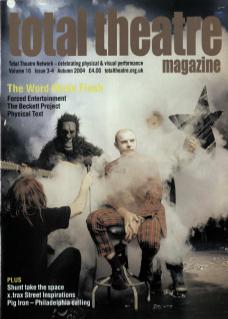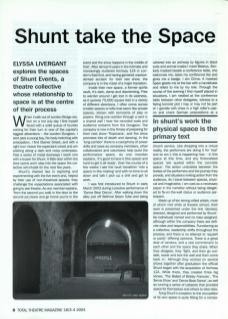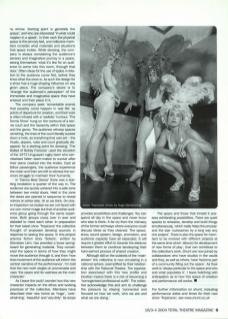When I walk out of London Bridge station on a hot July day I find myself faced with a solid queue of tourists waiting for their turn in one of the capital's biggest attractions – the London Dungeon. I skirt past a young boy, his body twitching with anticipation. I find Stainer Street, and with a right turn I leave the expectant crowd and am walking along a dark and noisy underpass. Past a series of metal doorways I reach one with a buzzer for Shunt. A little door within the door opens and I step into the space the collective will inhabit for the next few years.
Shunt's interest lies in exploring and experimenting with the live event and, helped by their use of non-theatrical spaces, they challenge the expectations associated with going to see theatre. As one member explains, ‘from the second you walk in the door to the second you leave and go home you're in the event and the show happens in the middle of that'. After almost six years in the intimate and increasingly cluttered Archway 12A in London's East End, and having garnered unprecedented acclaim for their last show, the company is in the midst of a major transition
Inside their new space, a former spirits vault, it's dark, damp and disorienting. Free to wander around I get lost in its vastness, as it sprawls 70,000 square feet in a variety of different directions. I often come across smaller spaces or lofts that seem like private spaces, strewn with remnants of play or papers. Along one corridor through a vent in a shared wall I hear the recorded wails and audience screams from the Dungeon. The company is now in the throes of preparing for their next show Tropicana, and the show promises lots of death and dancing. In the 'long corridor' there is a cacophony of power drills and saws as company members, other collaborators and volunteers help build the performance space. As one member explains, 'It's good to have it [the space] and hard to get it all ready.' Over the course of a few weeks I see the vault transform into a space-in-the-making and with no time to sit down and talk I pick up a drill and get to work.
I was first introduced to Shunt in early March 2003 during a preview performance of Dance Bear Dance. After walking down the alley just off Bethnal Green Tube and being ushered into an archway by figures in black suits and animal masks I meet Belarus. Similarly masked beside a conference table, she welcomes me, takes my conference fee and gives me a badge. I am China. A masked Spain greets me at the bar with a handshake and refers to me by my role. Through the course of the evening I find myself placed in situations. I am nestled at the conference table between other delegates, witness to a failing terrorist plot I may or may not be part of. I gamble with chips in a high roller's casino and chant German prepositions at a church service. Like dropping into a virtual reality, the performers are doing it for 'real' and so am I; this is happening now – in this space at this time, and any fictionalized spaces 'are quoted within the concrete space. The action undulates between the bodies of the performers and the journey they provide, and situations inviting action from the audience. As I travel between spaces, physical and imaginative, I am cast as a necessary player in the narrative without being relegated to fly-on-the-wall status or audience participant.
Made up of ten strong-willed artists, most of whom met while at theatre school, their work is presented under the line 'devised, directed, designed and performed by Shunt'. No individuals named and no roles assigned, although within the company there are definite roles and responsibilities. Functioning as a collective, leadership shifts throughout the process, and there is no attempt to 'squash or pacify’ differing opinions. There is a great deal of candour, and a real commitment to each other and the space they share. When they disagree, they ‘fight, and then go outside, swear and kick the wall and then come back in'. Although they worked on several shows together after graduation the official Shunt began with the acquisition of Archway 12A. While there, they created three big shows, The Ballad of Bobby Francois, The Tennis Show and Dance Bear Dance, as well as running a series of cabarets that provided space for themselves and others to take risks.
Tying Shunt's inception to the occupation of its own space is quite fitting for a company whose 'starting point is generally the space', and who are interested in ‘what could happen in a space'. In their work the physical space is the primary text, and collective members consider what materials and situations that space invites. While devising, the company is always considering the audience's sensory and imaginative journey in a space, asking themselves 'what it's like for an audience to come into this room, through that door.' Often ideas for the use of space in relation to the audience come first, before they know what the show is. As such the design for a show has a huge shaping influence on any given piece. The company's desire is to ‘change the audience's perception’ of the immediate and imaginative space they have entered and their place in it.
The company seek ‘remarkable events that possibly could happen in real life' as points of departure for creation, and their work is often infused with a 'sadistic' humour. The Tennis Show hung on the contours of a tennis court and the hierarchy within that space and the game. The audience witness spaces vanishing, the lines of the court literally sucked down a hole, as everything that was set – the rituals, players, rules and court – gradually disappears. As a starting point for devising, The Ballad of Bobby Francois used the situation of the 1972 Uruguayan rugby team who cannibalised fallen team-mates to survive after their plane crashed into the Andes. Cast as fellow passengers, the audience experience the crash and then are left to witness the survivors struggle to maintain their humanity.
In Dance Bear Dance there was a startling revelation a quarter of the way in. The audience are quickly ushered into a safe zone between two metal doors. Held in the zone the doors are opened in sequence to reveal mirrors on either side. Or so we think. On closer inspection we realise we are not faced with our own mirror image but that of another audience group going through the same experience. Both groups cross over in awe and disbelief to meet each other. In preparation for their latest show Tropicana the collective thought of proposed devising sources in response to seeing the space. In this project science fiction story Solaris, written by Stanislaw Lem, has provided a loose springboard for generating material. They considered the space in terms of how they might move the audience through it, and then 'how that movement of the audience will inform the central narrative of the performance'. I'm told that the new work verges on promenade and uses ‘the space and its vastness as the main character'.
As I leave the vault I wonder how this new character impacts on the ethos and working practices of the collective. Members have described their new home as 'huge', 'overwhelming', 'beautiful and very dirty'. Its scope provides possibilities and challenges. You can spend all day in the space and never know who else is there. A far cry from the intimacy of the former archways where everyone could discuss ideas as they cleaned. The space, show, sound system, design, promotion, and audience capacity have all expanded. It will require a greater effort to traverse the distance between them to continue developing their hard-earned process of shared creation.
Although still on the outskirts of the 'mainstream' the collective is now circulating in a national sphere, exemplified by their relationship with the National Theatre. The expectation associated with this new profile and location means there is a risk of becoming a ‘homogenised professional outfit'. The collective acknowledge this and aim to challenge the pressure by staying 'connected and focused on how we work, who we are and what we are doing'.
The space and those that inhabit it possess exhilarating possibilities. There are quiet spaces to rehearse, develop and build things simultaneously, which really helps the process and the size 'outreaches by a long way any one project'. There is also the space for members to be involved with different projects at the same time which allow(s) for development of new forms of play that can contribute to the collective's work. Shunt are now joined by collaborators who have studios in the vaults and they, as well as others, have ‘become part of a community filling out the space'. As their work is always particular to the space and ‘who and what populates it', I leave twitching with anticipation as to how this space of creation and performance will evolve.
For further information on shunt, including performance dates and times for their new show Tropicana, see www.shunt.co.uk


